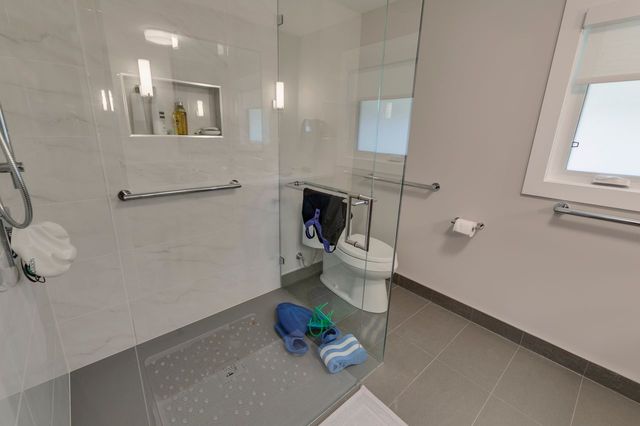As the saying goes – “your home is your castle”, it’s your safe place, a place you make memories, grow your family, enjoy friends old and new, meet new neighbours, and gain a community. We become very attached to our home and neighbourhood and for most of us, the goal is to remain in our home for as long as possible.
As we age, needs will often change, potentially making parts of the home unsafe, difficult, or even hazardous. Not all homes were built with the foresight to accommodate changing needs. As conditions with our health can change it is critical to make changes to our homes to reduce any risks. “Aging in place” isn’t about getting old, it’s about being prepared to ensure you can live in your home as comfortably and as safe as possible.

Photo Credit: Keith Henderson Photography | Builder: Abstract Homes and Renovations
Whether your needs are because you want to plan ahead, or you or someone in your family is starting to have health-related challenges, here are some tips to consider. Keep in mind that everyone’s needs are different and so not all solutions listed below may be applicable for your situation. This list, compliments of the Canadian Home Builders Association (CHBA), is just to give you an idea of some possible Adaptive Home renovation solutions.
- Install non-slip flooring in areas that may become wet, such as the bathroom or kitchen. This can greatly reduce the risk of falls.
- In the kitchen, pull-down shelves and drawers make it easier to access items without having to bend or stretch too far.
- When renovating your home, consider widening doorways to accommodate wheelchairs or walkers. Wider doorways and hallways can also make it easier to move furniture and alleviate congestion if you have a large household.
- In addition to grab bars, installing a shower seat or a walk-in bathtub will make bathing safer and easier.
- If you have a front porch or steps leading to your home’s entrance, consider installing a ramp or a vertical platform lift to make it more accessible for those with mobility impairments.
- Install handrails on both sides of stairs and walkways to provide extra support and stability.
- Make sure your lighting is adequate, especially in areas like hallways and stairways. Consider adding motion-sensor lights so that you always have enough light to see where you’re going.
- Install lever-style door handles instead of traditional round knobs, as they can be easier for people with limited dexterity to use.
- If you have a home with multiple levels, an elevator or stair lift will make it easier to move between floors.
- Install a smart home system that allows you to control various features of your home – such as lighting, temperature, and security – with voice commands or a smartphone app. This can be especially helpful for people with limited mobility or dexterity.
- Use contrasting colours to make it easier to navigate through your home. For example, you can use a darker colour for the edges of stairs to make them more visible.
- Consider installing a home monitoring system that can alert your loved ones or caregivers if you experience a fall or other emergency.

Photo Credit: Keith Henderson Photography | Builder: Abstract Homes and Renovations
Planning Ahead – Customizing to Individual Needs
Every homeowner’s situation is unique, which is why it is essential to work with experienced professionals who understand how to customize for a range of physical needs. The best renovators and builders will take time to understand not only the current requirements but also the future ones. These discussions will need to include all people living in the home, caregivers and or an occupational therapist. Open, sensitive, and confidential communication is crucial during this process. By thoroughly assessing your needs, both immediate and future, you can begin to design and implement changes that ensure your home remains a safe and comfortable place for years to come. The key to the success of any successful new build or renovation is in the planning stage. By discussing all needs up front, proper planning can help save you time and money, including the ability to plan for your adaptive home over stages to help minimize costs down the road.

Photo Credit: Keith Henderson Photography | Builder: Abstract Homes and Renovations
Hiring the Right Professional
Whether you’re looking to make small adjustments or undergo a major renovation, it’s important to hire a professional with experience in home adaptability. Look for a builder who belongs to your local Homebuilders Association, as they often have the expertise and knowledge to ensure the changes are made properly and safely.
Remember, your home should be a place of comfort, security, and happiness, regardless of the stage of life you’re in. Planning ahead, and making the necessary changes will help you maintain your independence and stay in the home you love for as long as you desire.
From small changes or large renovations, plan to hire a professional, such as Abstract Homes and Renovations, who are skilled in Aging-in-Place and Adaptiv Living, and members of your local Homebuilders Association.

















